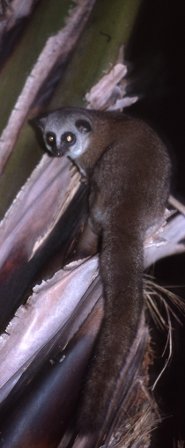 The Greater dwarf lemur (Cheirogaleus major), is a small primate that is native to eastern Madagascar. Reaching about nine inches (23 cm) in length (not including a tail of about eleven inches-28 cm) and weighs of about a pound 450 for males and four-fifths of a pound (350 g) for females, these lemurs have mainly darker gray or brown fur with lighter, whitish fur on their underbellies and faces. They have large, dark eyes surrounded by black rings.
The Greater dwarf lemur (Cheirogaleus major), is a small primate that is native to eastern Madagascar. Reaching about nine inches (23 cm) in length (not including a tail of about eleven inches-28 cm) and weighs of about a pound 450 for males and four-fifths of a pound (350 g) for females, these lemurs have mainly darker gray or brown fur with lighter, whitish fur on their underbellies and faces. They have large, dark eyes surrounded by black rings.This tiny primate is probably best known for its gigantic eyes, which are necessary because the Greater dwarf lemur is nocturnal. Greater dwarf lemurs are arboreal, meaning that they spend much of their time in the trees, where they build and, by day, sleep in communal nests. At night, the lemurs become active, preying on smaller animals, bugs, fruits and plant juices--however, despite the fact that they live together in troops, Greater dwarf lemurs spend much of their waking hours alone.
It goes through a period of inactivity during the austral winter called torpor (which is similar to hibernation, but differs mostly in that it does not last that long and does not involve as much of a drop in an animal's body temperature). Before torpor, the tail of the Greater dwarf lemur fills up with fat to sustain it through the season.
Mating pairs are monogamous and mate seasonally, with most births around October and typical pregnancies of about seventy days, usually producing litters of two offspring. Greater dwarf lemurs reach maturity after about one year and are sexually mature within their first ten to fourteen months of life. They are capable of living to about the age of thirteen years and are relatively plentiful throughout the eastern rainforest of Madigascar, enjoying a conservation status of LC (Least Concern) on the IUCN Red list. However, they are low on the food chain, and their predators include the ring-tailed mongoose, Madagascar buzzard, fossa, tenrecs, civets, larger nocturnal birds and snakes, and occasionally humans.
Picture of the greater dwarf lemur by Adam Britt, licensed under Creative Commons Attribution 3.0 Unported
The Greater dwarf lemur is listed as Least Concern (LR/lc), lowest risk. Does not qualify for a more at risk category. Widespread and abundant taxa are included in this category, on the IUCN Red List of Threatened Species
Namings for the greater dwarf lemur
A greater dwarf lemur group is called a 'troop'.Countries
MadagascarSome facts about the
Greater dwarf lemur
Adult weight : 0.395 kg (0.869 lbs)
Maximum longevity : 13 years
Female maturity :365 days
Male maturity : 365 days
Gestation : 65 days
Weaning : 47 days
Litter size : 2
Weight at birth : 0.018 kg (0.0396 lbs)

Custom Search